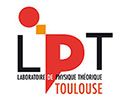Loading...
Présentation du LPT
Le LPT (UMR 5152, Laboratoire de Physique Théorique) est un laboratoire de recherche localisé sur le campus de l'Université Paul Sabatier de Toulouse. Il a été fondé en 1991 et a été créé administrativement en 2003. Les chercheurs du LPT étaient rattachés au Laboratoire de Physique Quantique au sein du Groupe de Physique Théorique. L'expertise du LPT couvre les domaines de la matière condensée et la matière molle ainsi que la physique statistique et la physique non-linéaire.
Le LPT est membre de la Fédération de recherche FeRMI (Fédération de recherche Matière et Interactions - FR2051), anciennement IRSAMC (Institut de Recherche sur les Systèmes Atomiques et Moléculaires Complexes).
Vous voulez-déposer un nouveau document ?
- Pas encore inscrit ? Inscrivez-vous
- Déposez une thèse : TEL (thèses en ligne)
- Documentation Hal
- Contact : documentation@irsamc.ups-tlse.fr
Les équipes de recherche
Consultez la politique des éditeurs en matière d'archivage
Derniers dépôts, tout type de documents
A harmonically trapped active Brownian particle exhibits two types of positional distributions—one has a single peak and the other has a single well—that signify steady-state dynamics with low and high activity, respectively. Adding inertia to the translational motion preserves this strict classification of either single-peak or single-well densities but shifts the dividing boundary between the states in the parameter space. We characterize this shift for the dynamics in one spatial dimension using the static Fokker-Planck equation for the full joint distribution of the state space. We derive local results analytically with a perturbation method for a small rotational velocity and then extend them globally with a numerical approach.
Using a high-accuracy variational Monte Carlo approach based on group-convolutional neural networks, we obtain the symmetry-resolved low-energy spectrum of the spin-1/2 Heisenberg model on several highly symmetric fullerene geometries, including the famous C60 buckminsterfullerene. We argue that as the degree of frustration is lowered in large fullerenes, they display characteristic features of incipient magnetic ordering: Correlation functions show high-intensity Bragg peaks consistent with Néel-like ordering, while the low-energy spectrum is organized into a tower of states. Competition with frustration, however, turns the simple Néel order into a noncoplanar one. Remarkably, we find and predict chiral incipient ordering in a large number of fullerene structures.
Quantum electrodynamics in <math display="inline"><mn>2</mn><mo>+</mo><mn>1</mn></math> dimensions (<math display="inline"><mrow><msub><mrow><mi>QED</mi></mrow><mrow><mn>3</mn></mrow></msub></mrow></math>) has been proposed as a critical field theory describing the low-energy effective theory of a putative algebraic Dirac spin liquid or of quantum phase transitions in two-dimensional frustrated magnets. We provide compelling evidence that the intricate spectrum of excitations of the elementary but strongly frustrated <math display="inline"><mrow><msub><mrow><mi>J</mi></mrow><mrow><mn>1</mn></mrow></msub><mtext>-</mtext><msub><mrow><mi>J</mi></mrow><mrow><mn>2</mn></mrow></msub></mrow></math> Heisenberg model on the triangular lattice is in one-to-one correspondence to a zoo of excitations from <math display="inline"><mrow><msub><mrow><mi>QED</mi></mrow><mrow><mn>3</mn></mrow></msub></mrow></math>, in the quantum spin liquid regime. This evidence includes a large manifold of explicitly constructed monopole and bilinear excitations of <math display="inline"><mrow><msub><mrow><mi>QED</mi></mrow><mrow><mn>3</mn></mrow></msub></mrow></math>, which is thus shown to serve as an organizing principle of phases of matter in triangular lattice antiferromagnets and their low-lying excitations. Moreover, we observe signatures of emergent valence-bond solid (VBS) correlations, which can be interpreted either as evidence of critical VBS fluctuations of an emergent Dirac spin liquid or as a transition from the 120° Néel order to a VBS whose quantum critical point is described by <math display="inline"><mrow><msub><mrow><mi>QED</mi></mrow><mrow><mn>3</mn></mrow></msub></mrow></math>. Our results are obtained by comparing ansatz wave functions from a parton construction to exact eigenstates obtained using large-scale exact diagonalization up to <math display="inline"><mi>N</mi><mo>=</mo><mn>48</mn></math> sites.
The subject of the thesis focuses on new approximations studied in a formalism based on a perturbation theory allowing to describe the electronic properties of many-body systems in an approximate way. We excite a system with a small disturbance, by sending light on it or by applying a weak electric field to it, for example and the system "responds" to the disturbance, in the framework of linear response, which means that the response of the system is proportional to the disturbance. The goal is to determine what we call the neutral excitations or bound states of the system, and more particularly the single excitations. These correspond to the transitions from the ground state to an excited state. To do this, we describe in a simplified way the interactions of the particles of a many-body system using an effective interaction that we average over the whole system. The objective of such an approach is to be able to study a system without having to use the exact formalism which consists in diagonalizing the N-body Hamiltonian, which is not possible for systems with more than two particles.
T-cell cytotoxic function relies on the cooperation between the highly specific but poorly adhesive T-cell receptor (TCR) and the integrin LFA-1. How LFA-1-mediated adhesion may scale with TCR stimulation strength is ill-defined. Here, we show that LFA-1 conformation activation scales with TCR stimulation to calibrate human T-cell cytotoxicity. Super-resolution microscopy analysis reveals that >1000 LFA-1 nanoclusters provide a discretized platform at the immunological synapse to translate TCR engagement and density of the LFA-1 ligand ICAM-1 into graded adhesion. Indeed, the number of high-affinity conformation LFA-1 nanoclusters increases as a function of TCR triggering strength. Blockade of LFA-1 conformational activation impairs adhesion to target cells and killing. However, it occurs at a lower TCR stimulation threshold than lytic granule exocytosis implying that it licenses, rather than directly controls, the killing decision. We conclude that the organization of LFA-1 into nanoclusters provides a calibrated system to adjust T-cell killing to the antigen stimulation strength.
